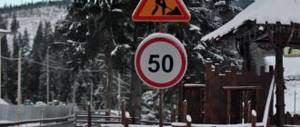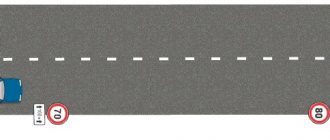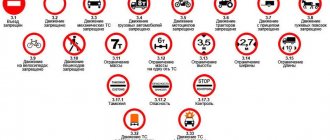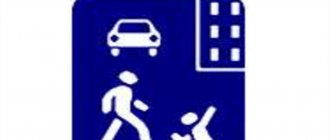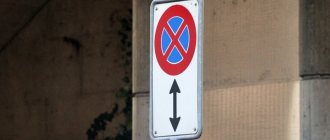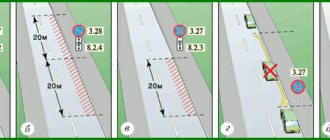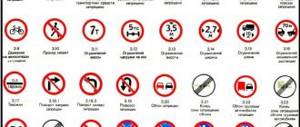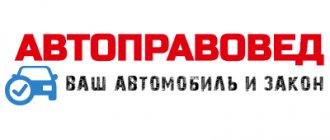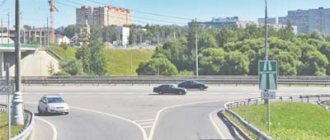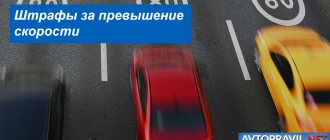Sign 3.24 “Maximum speed limit”
Road sign 3.24 “Maximum speed limit” is used to prohibit the movement of all vehicles at a speed higher than that indicated on the sign.
The sign is installed when on the next section of the road, for various reasons, it is necessary to enter a different maximum speed value (up or down) than it was on the previous section.
If a maximum speed is set on the next section of the road, which differs from the previous speed value by 20 km/h or more, a stepped speed limit is applied in increments of no more than 20 km/h by sequentially installing signs 3.24 at a distance of 100 - 150 meters from each other .
A stepped speed limit may not be applied in front of a populated area indicated by sign 5.23.1 or 5.23.2 ("Start of a populated area" signs with a white background), if the visibility distance of this sign is more than 150 meters.
Sign 3.24 with a sign 8.2.1 “Area of Operation” in front of the speed bump is installed together with sign 5.20 “Artificial Roughness” on one support. The speed indicated on the sign must be consistent with the design of the hump.
Restrictions and fines in the pedestrian zone
Today, many city streets in residential complexes are marked with “Pedestrian zone” signs.
This sign prohibits the entry of cars, imposing high fines for this. What restrictions apply in the area covered by this sign?
Features of the sign. The peculiarity of the “Pedestrian Zone” is that its designation requires the mandatory installation of a sign notifying the end of such a zone. In some cases, combined signs can be used, for example, 5.33 “Pedestrian zone”, with other types of information signs defining the time, day of the week or other conditions of use.
The peculiarity of the “Pedestrian zone” road sign is that its use requires the mandatory installation of a sign notifying the end of such a zone
According to the current version of the traffic rules, the movement of vehicles in the area covered by this sign is completely prohibited. The only exceptions can be those cases when the owner of the car lives in this zone and he does not have any other opportunity to drive up to his place of residence.
Most often, such signs are installed in the central part of cities, where entire streets or even neighborhoods can be designated for walking.
Most often, such signs are installed in the central part of cities, where entire streets or even neighborhoods can be designated for walking.
The need to use these signs. The number of cars in cities is constantly increasing every year. All this causes a situation where the city center is filled with cars, and many neighborhoods turn into one huge parking lot and a big traffic jam. To solve such problems, local authorities decide to introduce paid parking at the entrance to the city, limiting entry into the center, making it paid, or even installing “Pedestrian zone” signs, in which traffic is prohibited.
It is necessary to distinguish between two signs - “Pedestrian crossing” and “Pedestrian path”. The latter is a path on which only pedestrian traffic is allowed. For pedestrian zones, full-fledged roads, sidewalks, curbs, and unused roadways are allocated.
For pedestrian zones, full-fledged roads, sidewalks, curbs, and unused roadways are allocated.
Existence of exceptions. The Traffic Rules clearly stipulate which vehicles have the right to move in the pedestrian zone. This includes equipment of public utilities, vehicles supplying trade or other organizations located in the coverage area of such signs. In addition, citizens living on its territory can enter the pedestrian zone.
It should be borne in mind that pedestrians have priority over cars, but should not interfere with their movement. In addition, when entering and exiting such an area, drivers must give way to all cars traveling on the main road and cyclists. There is also a speed limit of 20 km/h.
According to current legislation, violation of the requirements of the “Pedestrian Zone” sign entails a fine of 2,000 rubles. For repeated violations, the fine will certainly be increased.
Conclusion. Nowadays in large cities there is often a sign “Pedestrian zone” where car traffic is prohibited. This is done in order to reduce gas pollution in central areas, and often these places are completely given over to pedestrians for walking. Only certain categories of vehicles can enter such a zone.
Effective area of sign 3.24 “Maximum speed limit”
The coverage area of sign 3.24 extends from the place where the sign is installed to the nearest intersection behind it, and in populated areas, in the absence of an intersection, to the end of the populated area.
The effect of the sign is not interrupted at exit points from areas adjacent to the road and at intersections (junctions) with field, forest and other secondary roads, in front of which there are no signs installed to identify the intersection as an intersection.
The effect of the “Maximum speed limit” sign, which is installed before a populated area, indicated by one of the signs 5.23.1 or 5.23.2 (“Beginning of a populated area” with a white background), extends to this sign, i.e. to the beginning of the settlement.
In a populated area, the speed of all vehicles is limited to 60 km/h, and when towing mechanical vehicles - 50 km/h (clause 10.2 of the traffic rules).
When limiting the speed on dangerous sections of the road (sharp turns, poor visibility of an oncoming car, narrowing of the road, etc.), the coverage area of the sign must correspond to the length of the dangerous section.
The length of the dangerous section can be established, for example, by using sign 3.24 of plate 8.2.1 “Area of Operation,” or indicated by installing sign 3.25 “End of maximum speed limit” at the end of the dangerous section.
The coverage area of the previous sign 3.24 “Maximum speed limit” can be changed (reduced or increased) by installing another sign 3.24 with a different maximum speed value.
Also, the effect of the “Maximum speed limit” sign can be canceled by installing sign 3.31 “End of the zone of all restrictions”. But when choosing your own speed limit, you should remember the speed limits both in the populated area and outside it for types of vehicles (section 10 of the traffic rules).
The yellow background of the “Maximum Speed Limit” sign means that the sign is installed temporarily. And you need to remember that if there are speed limit signs nearby on a white and yellow background with different meanings, then you should be guided by the temporary sign (Appendix 1 of the Traffic Regulations).
Installing speed limit signs
How symbols 3.24 should be used is described in the Methodological Recommendations of the Ministry of Internal Affairs and GOST R 52289-2004. Installation of speed limit signs must meet the following requirements:
- they must be located at a distance of 150-300 m from a dangerous area outside a populated area and at a distance of 50-100 m from it in a city or village;
- if the road in their area of operation has two or more lanes, 3.24 is duplicated on the dividing line;
- they do the same if it is not there, but there is oncoming traffic (the symbol is also placed to the left of the roadway with 1-2 lanes or above it with 3 or more lanes);
- if the area where you cannot drive quickly is large, the change in speed limit should be stepped (several signs are installed with gradually decreasing values of the maximum indicator);
- the previous rule does not apply if the symbol is used in front of a populated area and it is visible from more than 150 m.
More on AutoLex.Net:
Basic prohibitory traffic rules signs and fines for violation, coverage area of various signs
An important condition for use is that the “Speed Limit” sign must be clearly visible from a distance of at least 100 m. And the value of the maximum permissible indicator for it is chosen taking into account the terrain, the intensity of traffic and pedestrians. 3.24 will protect you from accidents on descents, sharp turns, on bridges, narrow roads, etc.
Watch this video about the pitfalls when placing speed limit signs:
Fine for violating sign 3.24 “Maximum speed limit”
Violation of the “Maximum Speed Limit” sign is interpreted in the Code of Administrative Offenses of the Russian Federation as exceeding the established speed. The administrative responsibility of the driver for speeding is determined by Article 12.9 of the Administrative Code, which includes 7 parts.
Each part provides for a fine for exceeding the next 20 km/h, including sanctions for repeated violations. The amount of the fine varies from 500 to 5000 rubles, and for exceeding more than 60 km/h, the license will be deprived (if the first time - up to six months, the second time - for 1 year).
At the time of publication of this article, there is still an unpunished speed limit of up to 20 km/h. Discussions are currently underway to lower this threshold to 10 km/h and to increase existing speeding fines. The changes are planned to be introduced in 2020.
Sign 3.25 “End of maximum speed limit zone”
Road sign 3.25 “End of maximum speed limit zone” is used to indicate the place where the limit of sign 3.24 ends, i.e. The previously imposed speed limit is lifted.
On roads with one, two or three lanes for traffic in both directions, the “End of maximum speed limit zone” sign may be installed only on the left side of the road, placing it on the reverse side of sign 3.24, which is intended for drivers of vehicles moving in the opposite direction.
The yellow background of the “End of maximum speed limit zone” sign means that the sign is temporary.
Sign 3.26 “Sound signal prohibited”
The “No Sound Signal” sign is installed only outside populated areas. It can be found on sections of roads passing in close proximity to sanatoriums, rest homes, health camps, hospitals, etc.
Paragraph 19.10 of the Traffic Regulations allows the use of sound signals only in two cases:
- to warn other drivers of the intention to overtake outside populated areas;
- when a sound signal is necessary to prevent an accident in order to attract attention.
Road sign 3.26 “Sound signal prohibited” is used to prohibit the sound signal, except in cases where the signal is necessary to prevent an accident. Since traffic rules outside populated areas only allow honking to prevent accidents and to warn about overtaking (and sign 3.26 is used only outside populated areas), it is prohibited to honk in the coverage area of sign 3.26 to warn about overtaking.
The coverage area of sign 3.26 extends from the place where the sign is installed to the nearest intersection behind it. The effect of the sign is not interrupted at places of exit from adjacent territories and at places of intersection (junction) with field, forest and other secondary roads, in front of which there are no signs installed that allow the intersection to be interpreted as an intersection.
Signs 5.27 “Restricted parking zone” and 5.28 “End of restricted parking zone”
Sign 5.27 “Restricted parking zone” indicates the beginning of a section of road or territory within which parking is prohibited. Sign 5.27 is installed at all entrances to this section of the road (territory).
The “Restricted Parking Zone” sign extends its effect to the entire territory in front of which it is installed, or to both sides of the road. If an intersection falls into this zone, then the operation of sign 5.27 beyond the intersection is not interrupted.
The parking ban may not apply to all wheeled road users, but only to certain types of vehicles. Or parking restrictions may be in effect at certain times.
In such cases, the relevant information about the types of vehicles that are subject to the parking ban, about the time of action or its duration, is placed on plates under the signs or it is placed at the bottom of the sign 5.27.
Sign 5.28 “End of restricted parking zone” indicates the end of a section of road or area that has been designated by sign 5.27. The sign is installed at all exits from the territory (road section).
After sign 5.28, parking of the vehicle must be carried out in accordance with section 12 of the traffic rules. The places where parking is prohibited are determined by clause 12.5 of the traffic rules.
Fine for violating sign 3.26 “Sound signal is prohibited”
For violating the rules for using sound signals, the driver may be subject to sanctions in the form of a warning or a fine of 500 rubles. in accordance with Art. 12.20 Code of Administrative Offences.
Since sign 3.26 is installed only outside the populated area, violation of the requirements of this sign can only be discussed outside the populated area.
In populated areas, sounding a sound signal is prohibited even without a sign (except for cases where the signal is related to preventing an accident). Therefore, those who like to honk, for example, in the courtyard of a house, may be subject to sanctions under the above article.
A complete list of prohibitory road signs with brief comments (explanations) on the website is posted in Appendix 1 of the Traffic Regulations.
Navigation through the series of articles<< Prohibitory road signs 3.20-3.23 Prohibitory road signs 3.27-3.30 >>
